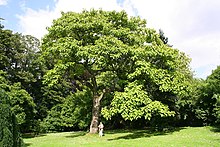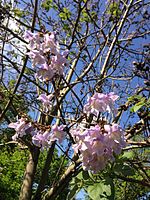
A cactus is a member of the plant family Cactaceae, a family comprising about 127 genera with some 1,750 known species of the order Caryophyllales. The word cactus derives, through Latin, from the Ancient Greek word κάκτος (káktos), a name originally used by Theophrastus for a spiny plant whose identity is now not certain. Cacti occur in a wide range of shapes and sizes. They are native to the Americas, ranging from Patagonia in the south to parts of western Canada in the north, with the exception of Rhipsalis baccifera, which is also found in Africa and Sri Lanka. Cacti are adapted to live in very dry environments, including the Atacama Desert, one of the driest places on Earth. Because of this, cacti show many adaptations to conserve water. For example, almost all cacti are succulents, meaning they have thickened, fleshy parts adapted to store water. Unlike many other succulents, the stem is the only part of most cacti where this vital process takes place. Most species of cacti have lost true leaves, retaining only spines, which are highly modified leaves. As well as defending against herbivores, spines help prevent water loss by reducing air flow close to the cactus and providing some shade. In the absence of true leaves, cacti's enlarged stems carry out photosynthesis.

Catalpa, commonly also called catawba, is a genus of flowering plants in the family Bignoniaceae, native to warm temperate and subtropical regions of North America, the Caribbean, and East Asia.

Campsis radicans, the trumpet vine, yellow trumpet vine, or trumpet creeper, is a species of flowering plant in the trumpet vine family Bignoniaceae, native to eastern North America, and naturalized elsewhere. Growing to 10 metres, it is a vigorous, deciduous woody vine, notable for its showy trumpet-shaped flowers. It inhabits woodlands and riverbanks, and is also a popular garden plant.

Alnus glutinosa, the common alder, black alder, European alder, European black alder, or just alder, is a species of tree in the family Betulaceae, native to most of Europe, southwest Asia and northern Africa. It thrives in wet locations where its association with the bacterium Frankia alni enables it to grow in poor quality soils. It is a medium-sized, short-lived tree growing to a height of up to 30 metres (98 feet). It has short-stalked rounded leaves and separate male and female flowers in the form of catkins. The small, rounded fruits are cone-like and the seeds are dispersed by wind and water.

Prunus laurocerasus, also known as cherry laurel, common laurel and sometimes English laurel in North America, is an evergreen species of cherry (Prunus), native to regions bordering the Black Sea in southwestern Asia and southeastern Europe, from Albania and Bulgaria east through Turkey to the Caucasus Mountains and northern Iran.

In botany, a perennial plant or simply perennial is a plant that lives more than two years. The term is often used to differentiate a plant from shorter-lived annuals and biennials. The term is also widely used to distinguish plants with little or no woody growth from trees and shrubs, which are also technically perennials. Notably, it is estimated that 94% of plant species fall under the category of perennials, underscoring the prevalence of plants with lifespans exceeding two years in the botanical world.

Paulownia is a genus of seven to 17 species of hardwood trees in the family Paulowniaceae, the order Lamiales. The genus and family are native to east Asia and are widespread across China. The genus, originally Pavlovnia but now usually spelled Paulownia, was named in honour of Anna Pavlovna, queen consort of The Netherlands (1795–1865), daughter of Tsar Paul I of Russia. It is also called "princess tree" for the same reason.

Paulowniaceae are a family of flowering plants within the Lamiales. They are a monophyletic and monogeneric family of trees with currently 7 confirmed species. They were formerly placed within Scrophulariaceae sensu lato, or as a segregate of the Bignoniaceae.

Grevillea robusta, commonly known as the southern silky oak, silk oak or silky oak, silver oak or Australian silver oak, is a flowering plant in the family Proteaceae, and accordingly unrelated to true oaks, family Fagaceae. Grevillea robusta is a tree, and is the largest species in its genus. It is a native of eastern coastal Australia, growing in riverine, subtropical and dry rainforest environments.

Portulaca grandiflora is a succulent flowering plant in the purslane family Portulacaceae, native to southern Brazil, Argentina, and Uruguay and often cultivated in gardens. It has many common names, including rose moss, eleven o'clock, Mexican rose, moss rose, sun rose, table rose, rock rose, and moss-rose purslane. Despite these names and the superficial resemblance of some cultivars' flowers to roses, it is not a true rose, nor even a part of the rose family or rosid group; rather, it is much more closely related to carnations and cacti.

Digitalis lanata, vernacularly often called woolly foxglove or Grecian foxglove, is a species of foxglove, a flowering plant in the plantain family Plantaginaceae. It gets its name due to the woolly indumentum of the leaves. D. lanata, like other foxglove species, is toxic in all parts of the plant. Symptoms of digitalis poisoning include nausea, vomiting, severe headache, dilated pupils, problems with eyesight, and convulsions at the worst level of toxicity. The plant is also harmful to other animals.

Populus tremula is a species of poplar native to cool temperate regions of the Old World.

Mesembryanthemum crystallinum is a prostrate succulent plant native to Africa, Sinai and southern Europe, and naturalized in the New World. The plant is covered with large, glistening bladder cells or water vesicles, reflected in its common names of common ice plant, crystalline ice plant or ice plant.

Prunus tomentosa is a species of Prunus native to northern and western China, Korea, Mongolia, and possibly northern India. Common names for Prunus tomentosa include Nanjing cherry, Korean cherry, Manchu cherry, downy cherry, Shanghai cherry, Ando cherry, mountain cherry, Chinese bush cherry, and Chinese dwarf cherry.
A xerophyte is a species of plant that has adaptations to survive in an environment with little liquid water. Examples of xerophytes include cacti, pineapple and some gymnosperm plants. The morphology and physiology of xerophytes are adapted to conserve water during dry periods. Some species called resurrection plants can survive long periods of extreme dryness or desiccation of their tissues, during which their metabolic activity may effectively shut down. Plants with such morphological and physiological adaptations are said to be xeromorphic. Xerophytes such as cacti are capable of withstanding extended periods of dry conditions as they have deep-spreading roots and capacity to store water. Their waxy, thorny leaves prevent loss of moisture.

Verbascoside is a polyphenol glycoside in which the phenylpropanoid caffeic acid and the phenylethanoid hydroxytyrosol form an ester and an ether bond respectively, to the rhamnose part of a disaccharide, namely β-(3′,4′-dihydroxyphenyl)ethyl-O-α-L-rhamnopyranosyl(1→3)-β-D-(4-O-caffeoyl)-glucopyranoside.
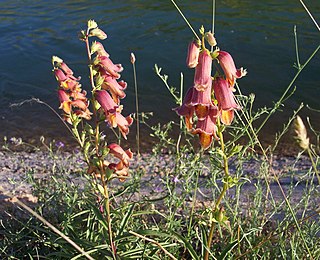
Digitalis obscura, commonly called willow-leaved foxglove or dusty foxglove or spanish rusty foxglove, is a flowering plant native to regions in Spain and Morocco. It is also grown as an ornamental flower. This foxglove is a woody perennial plant belonging to the family Plantaginaceae. Along with the other foxgloves it used to be placed in the figwort family, Scrophulariaceae; however, recent genetic research has moved the genus Digitalis to a larger family. It is similar to many of the foxglove species in its high toxicity and medicinal use as a source for the heart-regulating drug digoxin. Its strikingly distinctive amber- to copper-coloured flowers give the species its name and help distinguish it from other members of the genus.
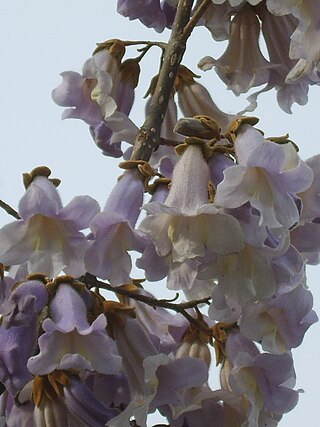
Paulownia coreana, also called Paulownia glabrata or Korean paulownia, is an indigenous species of South Korea. It is cultivated in South Pyongan and south of Gyeonggi.
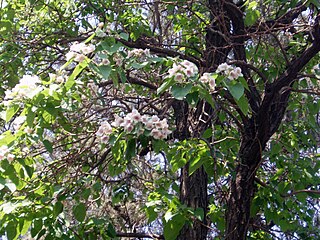
Paulownia fortunei commonly called the dragontree, dragon tree or Fortune's empress tree, is a deciduous tree in the family Paulowniaceae, native to southeastern China (including Taiwan), Laos and Vietnam. It is an extremely fast-growing tree, due to its use of C4 carbon fixation, and is planted for timber harvesting. It appears to be nowhere near as dangerously invasive as Paulownia tomentosa.

Carpobrotus modestus, commonly known as inland pigface, is a succulent perennial of the family Aizoaceae, native to Australia. It produces purple flowers which mature into fruits and is mainly used as a groundcover succulent or as a drought tolerant plant.
